The Flame Detector Market is estimated to be valued at USD 2.0 billion in 2025 and is projected to reach USD 3.2 billion by 2035, registering a compound annual growth rate (CAGR) of 5.0% over the forecast period.
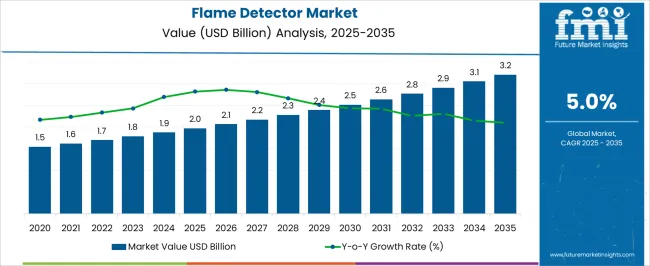
| Metric | Value |
|---|---|
| Flame Detector Market Estimated Value in (2025 E) | USD 2.0 billion |
| Flame Detector Market Forecast Value in (2035 F) | USD 3.2 billion |
| Forecast CAGR (2025 to 2035) | 5.0% |
The Flame Detector market is experiencing steady growth, driven by increasing demand for fire and safety systems across industrial, commercial, and energy sectors. The adoption of flame detection technologies is being fueled by stringent safety regulations, rising awareness of fire hazards, and the need to protect critical infrastructure. Advanced flame detection systems incorporating multi-sensor technologies, infrared and ultraviolet sensors, and real-time monitoring capabilities are enhancing detection accuracy and response times.
Integration with broader industrial safety and automation systems is further supporting market adoption. Growing investments in oil and gas, chemical, and power generation industries are driving demand for reliable flame detection solutions that can operate in challenging environments. Increasing focus on minimizing downtime, preventing asset damage, and ensuring employee safety is contributing to wider deployment.
As regulatory frameworks evolve and industrial automation continues to expand, flame detector systems are expected to play an essential role in safety management Continuous technological innovations and service enhancements are likely to sustain growth over the next decade.
The flame detector market is segmented by product type, service, verticals, and geographic regions. By product type, flame detector market is divided into Multi IR, Single IR, Dual UV/IR, Single UV, and Triple IR (IR3). In terms of service, flame detector market is classified into Engineering Services, Installation & Design Services, Maintenance Service, Inspection, and Managed Services. Based on verticals, flame detector market is segmented into Oil And Gas Industry, Automotive, Consumer Goods And Retail, Healthcare, Energy And Power, Manufacturing, Transportation And Logistics, Aerospace And Defense, and Others. Regionally, the flame detector industry is classified into North America, Latin America, Western Europe, Eastern Europe, Balkan & Baltic Countries, Russia & Belarus, Central Asia, East Asia, South Asia & Pacific, and the Middle East & Africa.
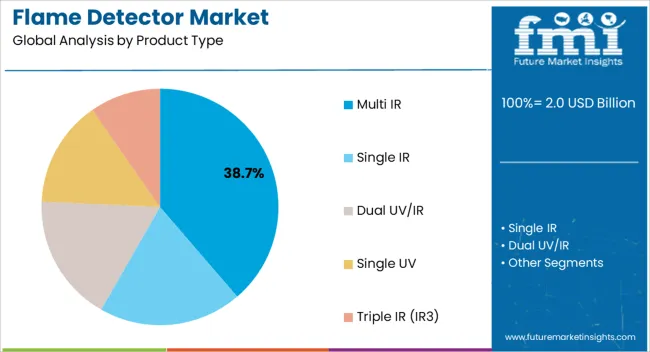
The multi IR product type segment is projected to hold 38.7% of the market revenue in 2025, making it the leading product type. Its dominance is being driven by the enhanced detection accuracy and reliability provided by multiple infrared sensors, which can detect flames across a wide range of distances and environmental conditions.
Multi IR flame detectors are particularly effective in minimizing false alarms, as they can differentiate between actual flame sources and background radiation or heat. Their ability to integrate with industrial automation and safety systems ensures rapid response to fire incidents, reducing potential operational and asset losses.
The reliability, robustness, and adaptability of multi IR detectors in hazardous and challenging environments have strengthened their adoption in key industrial sectors As industries continue to prioritize workplace safety, regulatory compliance, and process continuity, the multi IR product type segment is expected to maintain its leading market position, supported by continuous technological innovation and enhanced performance standards.
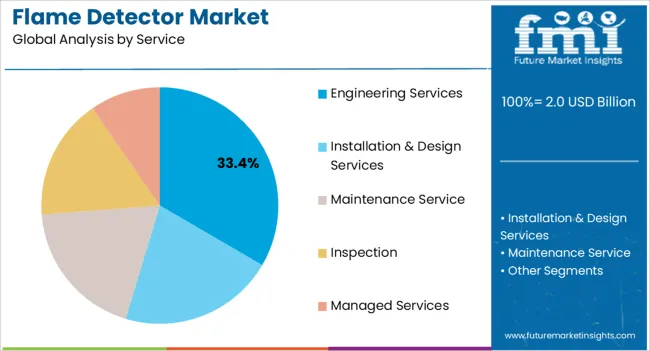
The engineering services segment is anticipated to account for 33.4% of the market revenue in 2025, making it the leading service category. Growth in this segment is being driven by the demand for specialized design, installation, and maintenance services to ensure optimal performance and reliability of flame detection systems. Engineering services facilitate the customization of detection solutions for specific operational environments, compliance with safety regulations, and integration with existing industrial infrastructure.
Service providers enable predictive maintenance, real-time monitoring, and calibration, reducing downtime and enhancing system efficiency. Increasing awareness of fire hazards, coupled with the need for cost-effective and high-performance safety solutions, is further supporting the adoption of engineering services.
Organizations are relying on these services to ensure operational continuity, minimize risk exposure, and enhance workplace safety As industrial operations continue to expand and safety compliance standards tighten, engineering services are expected to remain a key growth driver in the flame detector market, ensuring that systems perform effectively throughout their operational lifecycle.
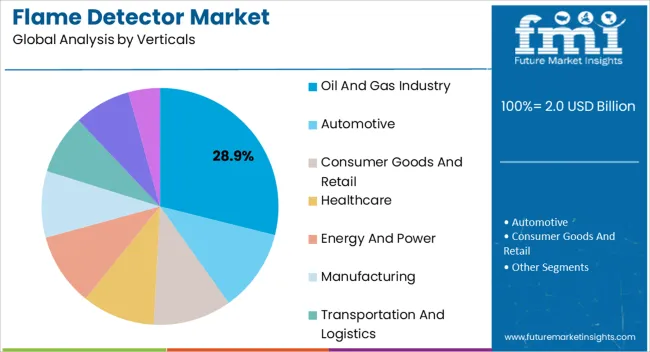
The oil and gas industry vertical is projected to hold 28.9% of the market revenue in 2025, establishing it as the leading end-use sector. Growth in this segment is driven by the high risk of fire hazards inherent in upstream, midstream, and downstream operations, where flammable gases and liquids are handled. Flame detectors are critical for ensuring operational safety, protecting assets, and complying with strict regulatory standards.
Multi-sensor and infrared flame detection technologies are widely adopted to address challenging environmental conditions, including extreme temperatures, high humidity, and the presence of dust or vapors. The need for continuous monitoring, rapid response to potential fire incidents, and integration with safety and control systems reinforces adoption.
As oil and gas operations expand globally and safety regulations tighten, the reliance on advanced flame detection solutions is expected to increase The combination of high-risk operational environments and regulatory enforcement ensures that the oil and gas industry remains the primary contributor to flame detector market growth.
The global flame detector market reached a value of US$ 1.7 Billion in 2025. FMI expects the market to reach US$ 2.77 Billion by 2035, growing at a CAGR of 5% from 2025 to 2035.
| Attributes | Details |
|---|---|
| Market CAGR | 5% |
| Market (2025) | US$ 1.7 Billion |
| Market (2035) | US$ 2.77 Billion |
Major companies have taken numerous initiatives and efforts to provide a safe working environment for their employees, which drives the market for flame detectors. But the market's growth is restricted by high initial costs, excessive maintenance charges, and a lack of awareness due to high initial costs and excessive maintenance charges.
Government regulations and training initiatives to educate employees about workplace safety are creating more opportunities for flame detectors around the globe. The key drivers of the flame detector market are the growing implementation of technology, the increase in adoption from key industries, and the strict policies and regulations for fire protection.
There is currently an industrial space crunch in some core markets such as warehouses/distribution, manufacturing, and technology, which is driving growth in commercial real estate demand. The demand for fire and building safety systems is expected to rise as the industrial real estate market grows.
This is because this industry has a high focus on building, asset, and personnel safety. Thus, the rising demand and growth in commercial real estate is a lucrative opportunity for the flame detector market.
Key Takeaways:
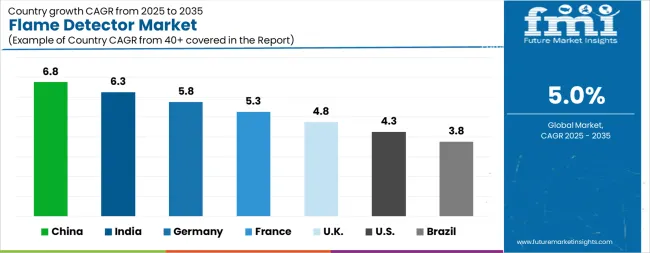
| Country | CAGR |
|---|---|
| China | 6.8% |
| India | 6.3% |
| Germany | 5.8% |
| France | 5.3% |
| UK | 4.8% |
| USA | 4.3% |
| Brazil | 3.8% |
The Flame Detector Market is expected to register a CAGR of 5.0% during the forecast period, exhibiting varied country level momentum. China leads with the highest CAGR of 6.8%, followed by India at 6.3%. Developed markets such as Germany, France, and the UK continue to expand steadily, while the USA is likely to grow at consistent rates. Brazil posts the lowest CAGR at 3.8%, yet still underscores a broadly positive trajectory for the global Flame Detector Market. In 2024, Germany held a dominant revenue in the Western Europe market and is expected to grow with a CAGR of 5.8%. The USA Flame Detector Market is estimated to be valued at USD 702.4 million in 2025 and is anticipated to reach a valuation of USD 1.1 billion by 2035. Sales are projected to rise at a CAGR of 4.3% over the forecast period between 2025 and 2035. While Japan and South Korea markets are estimated to be valued at USD 94.4 million and USD 64.4 million respectively in 2025.
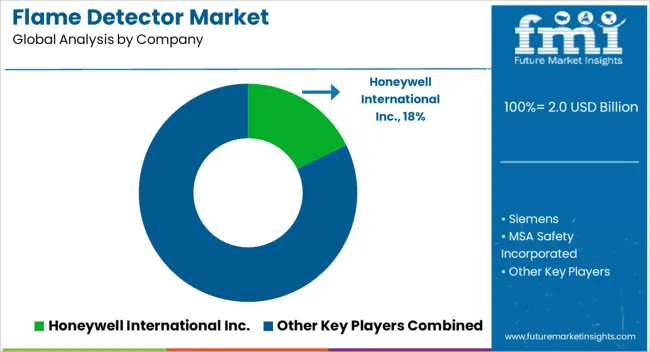
| Item | Value |
|---|---|
| Quantitative Units | USD 2.0 Billion |
| Product Type | Multi IR, Single IR, Dual UV/IR, Single UV, and Triple IR (IR3) |
| Service | Engineering Services, Installation & Design Services, Maintenance Service, Inspection, and Managed Services |
| Verticals | Oil And Gas Industry, Automotive, Consumer Goods And Retail, Healthcare, Energy And Power, Manufacturing, Transportation And Logistics, Aerospace And Defense, and Others |
| Regions Covered | North America, Europe, Asia-Pacific, Latin America, Middle East & Africa |
| Country Covered | United States, Canada, Germany, France, United Kingdom, China, Japan, India, Brazil, South Africa |
| Key Companies Profiled | Honeywell International Inc., Siemens, MSA Safety Incorporated, Drägerwerk AG & Co. KGaA, Teledyne Gas and Flame Detection, Det-Tronics, Emerson Electric Co., Johnson Controls, Spectrex, and REZONTECH CO., LTD. |
The global flame detector market is estimated to be valued at USD 2.0 billion in 2025.
The market size for the flame detector market is projected to reach USD 3.2 billion by 2035.
The flame detector market is expected to grow at a 5.0% CAGR between 2025 and 2035.
The key product types in flame detector market are multi ir, single ir, dual uv/ir, single UV and triple ir (ir3).
In terms of service, engineering services segment to command 33.4% share in the flame detector market in 2025.






Our Research Products

The "Full Research Suite" delivers actionable market intel, deep dives on markets or technologies, so clients act faster, cut risk, and unlock growth.

The Leaderboard benchmarks and ranks top vendors, classifying them as Established Leaders, Leading Challengers, or Disruptors & Challengers.

Locates where complements amplify value and substitutes erode it, forecasting net impact by horizon

We deliver granular, decision-grade intel: market sizing, 5-year forecasts, pricing, adoption, usage, revenue, and operational KPIs—plus competitor tracking, regulation, and value chains—across 60 countries broadly.

Spot the shifts before they hit your P&L. We track inflection points, adoption curves, pricing moves, and ecosystem plays to show where demand is heading, why it is changing, and what to do next across high-growth markets and disruptive tech

Real-time reads of user behavior. We track shifting priorities, perceptions of today’s and next-gen services, and provider experience, then pace how fast tech moves from trial to adoption, blending buyer, consumer, and channel inputs with social signals (#WhySwitch, #UX).

Partner with our analyst team to build a custom report designed around your business priorities. From analysing market trends to assessing competitors or crafting bespoke datasets, we tailor insights to your needs.
Supplier Intelligence
Discovery & Profiling
Capacity & Footprint
Performance & Risk
Compliance & Governance
Commercial Readiness
Who Supplies Whom
Scorecards & Shortlists
Playbooks & Docs
Category Intelligence
Definition & Scope
Demand & Use Cases
Cost Drivers
Market Structure
Supply Chain Map
Trade & Policy
Operating Norms
Deliverables
Buyer Intelligence
Account Basics
Spend & Scope
Procurement Model
Vendor Requirements
Terms & Policies
Entry Strategy
Pain Points & Triggers
Outputs
Pricing Analysis
Benchmarks
Trends
Should-Cost
Indexation
Landed Cost
Commercial Terms
Deliverables
Brand Analysis
Positioning & Value Prop
Share & Presence
Customer Evidence
Go-to-Market
Digital & Reputation
Compliance & Trust
KPIs & Gaps
Outputs
Full Research Suite comprises of:
Market outlook & trends analysis
Interviews & case studies
Strategic recommendations
Vendor profiles & capabilities analysis
5-year forecasts
8 regions and 60+ country-level data splits
Market segment data splits
12 months of continuous data updates
DELIVERED AS:
PDF EXCEL ONLINE
Flame Ionization Detectors Market Size and Share Forecast Outlook 2025 to 2035
Flameproof Equipment Market Size and Share Forecast Outlook 2025 to 2035
Flame Barrier Market Size and Share Forecast Outlook 2025 to 2035
Flame Resistant Fabrics Market Size and Share Forecast Outlook 2025 to 2035
Flame Retardant Masterbatch Market Size and Share Forecast Outlook 2025 to 2035
Flame Photometer Market Size and Share Forecast Outlook 2025 to 2035
Flame Proof Lighting Market Growth 2025 to 2035
Flame Retardant Chemicals Market Growth - Trends & Forecast 2025 to 2035
Flame Retardant Film Market Analysis & Forecast 2024-2034
Flame Retardant Market Growth – Trends & Forecast 2024-2034
Flame Arrester Market
XEDS Detectors Market Size and Share Forecast Outlook 2025 to 2035
Radar Detectors Market Size and Share Forecast Outlook 2025 to 2035
Smoke Detector Market Insights – Growth & Forecast through 2034
Cable Detector Market
Aramid Flame Retardant Webbing Market Size and Share Forecast Outlook 2025 to 2035
AI-Powered Age Detection – Future of Digital Verification
Quantum Detector Market Size and Share Forecast Outlook 2025 to 2035
Voltage Detector Market Size and Share Forecast Outlook 2025 to 2035
Neutron Detectors Market Analysis - Size, Growth, and Forecast 2025 to 2035

Thank you!
You will receive an email from our Business Development Manager. Please be sure to check your SPAM/JUNK folder too.
Chat With
MaRIA